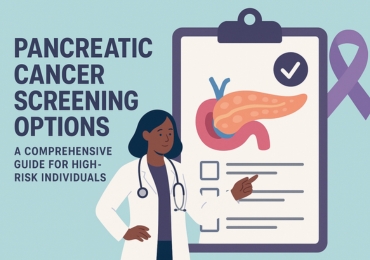Estimated reading time: 12 minutes
Key Takeaways
- Targeted screening is recommended for individuals with elevated pancreatic cancer risk, not the general population.
- High-risk candidates include those with two or more first-degree relatives with pancreatic cancer or carriers of hereditary cancer syndrome mutations.
- Primary screening methods are MRI/MRCP and endoscopic ultrasound (EUS), each offering distinct advantages.
- Screening typically begins at age 50 or ten years before the youngest family diagnosis.
- Genetic counseling plays a crucial role in risk assessment and screening decisions.
- Early detection through screening can dramatically improve treatment options and outcomes.
Table of contents
- Understanding the Critical Role of Screening
- Identifying Candidates for Screening
- Available Screening Modalities
- Special Considerations for High-Risk Families
- The Value of Genetic Counseling
- Preparing for a Screening Appointment
- Interpreting Results and Next Steps
- Conclusion and Additional Support
- Frequently Asked Questions
Pancreatic cancer remains one of oncology’s most formidable challenges, primarily because it so often evades detection until advanced stages. For individuals with elevated risk due to family history or genetic predisposition, this reality makes informed screening decisions not just prudent, but potentially life-saving.
The disease’s silent progression underscores why proactive screening strategies are vital for those at increased risk. Early detection can dramatically shift treatment possibilities and outcomes, opening doors to interventions that are significantly more effective.
This guide examines the current landscape of pancreatic cancer screening, focusing on evidence-based approaches for high-risk individuals and families. We’ll explore who should consider screening, the available methods, and how to navigate the process from genetic counseling to follow-up care.
The National Pancreatic Cancer Foundation (NPCF) supports this mission through research funding, patient education, and advocacy, contributing to the evolving science of early detection.
Understanding the Critical Role of Screening
Pancreatic cancer’s reputation for late-stage diagnosis isn’t incidental. The organ’s deep anatomical location and the disease’s initial subtlety mean symptoms frequently emerge only after substantial progression. This biological reality positions screening as a critical tool for those at known risk.
The statistical contrast is stark: survival rates for localized pancreatic cancer significantly exceed those for advanced disease. When detected early, surgical resection—often not an option at later stages—becomes possible, fundamentally changing the treatment trajectory.
Unfortunately, only a small percentage of pancreatic cancers are currently caught at these early, manageable stages within the general population. This gap highlights the importance of targeted screening programs that focus resources on those with demonstrated elevated risk.
Ongoing research, including studies supported by the NPCF, continues to refine screening technologies and protocols. These advances aim to improve detection sensitivity and specificity, ultimately increasing the number of early diagnoses.
Identifying Candidates for Screening
Screening recommendations for pancreatic cancer are specifically tailored to individuals with substantially elevated risk. The general population does not typically require screening, as the potential harms of false positives and unnecessary procedures outweigh the benefits.
High-Risk Categories
Familial Risk Patterns:
Individuals with two or more first-degree relatives (parents, siblings, or children) diagnosed with pancreatic cancer constitute a clearly defined high-risk group. This pattern suggests either shared environmental factors or an inherited genetic susceptibility.
Multi-generational family histories that include related cancers—particularly breast, ovarian, or colorectal cancers, may also indicate hereditary cancer syndromes that elevate pancreatic cancer risk.
Hereditary Syndrome Carriers:
Specific genetic mutations confer significantly increased pancreatic cancer risk. These include:
- BRCA1 and BRCA2 mutations
- PALB2 mutations
- CDKN2A mutations
- ATM gene mutations
- Lynch syndrome mutations
- Peutz-Jeghers syndrome
- Familial atypical multiple mole melanoma (FAMMM) syndrome
Each syndrome carries distinct risk profiles, making genetic evaluation essential for determining appropriate screening strategies.
Screening Initiation and Timing
For most high-risk individuals, screening begins at age 50. However, this should be adjusted based on family history, specifically, starting ten years before the youngest diagnosis in the family.
Certain genetic conditions warrant earlier initiation. Those with Peutz-Jeghers syndrome, for instance, should typically begin screening between ages 35 and 40 due to their markedly elevated risk profile.
Professional Guidelines
Reputable organizations including the Cancer of the Pancreas Screening (CAPS) Consortium, National Comprehensive Cancer Network (NCCN), and American Society for Gastrointestinal Endoscopy (ASGE) have established evidence-based guidelines for pancreatic cancer screening. These recommendations help ensure that screening efforts focus on appropriate candidates using validated approaches.
Available Screening Modalities
Current screening approaches primarily rely on advanced imaging techniques, each offering distinct advantages for pancreatic visualization and early detection.
Imaging Technologies
Magnetic Resonance Imaging (MRI) and Magnetic Resonance Cholangiopancreatography (MRCP):
These noninvasive imaging methods provide detailed visualization of the pancreas without radiation exposure. MRCP specifically focuses on the pancreatic and bile ducts, offering enhanced detail of these critical structures.
The safety profile of MRI makes it particularly suitable for annual surveillance in high-risk populations. The technology effectively identifies masses, cysts, and parenchymal abnormalities that might indicate early malignancy.
Endoscopic Ultrasound (EUS):
This minimally invasive procedure combines endoscopy with ultrasound technology, positioning a high-frequency transducer in close proximity to the pancreas via the stomach. This proximity allows for exceptionally detailed imaging of pancreatic tissue.
A significant advantage of EUS is its ability to obtain tissue samples through fine needle aspiration if suspicious lesions are identified. This biopsy capability provides pathological confirmation that imaging alone cannot offer.
Additional Imaging Options:
Computed tomography (CT) scans and Endoscopic Retrograde Cholangiopancreatography (ERCP) play important roles in diagnostic evaluation but are not typically used for routine screening in high-risk individuals.
Emerging Biomarkers and Blood Tests
While the tumor marker CA 19-9 has utility in monitoring known pancreatic cancer, its sensitivity and specificity limitations prevent its use as a reliable screening tool. Research continues into novel biomarkers and artificial intelligence applications that may eventually transform early detection capabilities, though these remain investigational.
Comparative Considerations
MRI/MRCP Advantages:
- Noninvasive with no radiation exposure
- Excellent soft tissue visualization
- Suitable for repeated annual screening
- Comprehensive anatomical assessment
MRI/MRCP Limitations:
- Higher cost than some alternatives
- Potential for detecting incidental findings requiring follow-up
- Contraindicated with certain implants
- May provoke claustrophobia
EUS Advantages:
- Superior resolution for small lesions
- Biopsy capability during procedure
- Detailed assessment of ductal structures
EUS Considerations:
- Requires sedation
- Minimally invasive with minimal recovery
- Small risk of procedure-related complications
Screening Intervals and Expertise
Most guidelines recommend annual screening for high-risk individuals. Some programs alternate between MRI and EUS annually to leverage the strengths of both modalities while managing the limitations of each.
Screening should ideally occur at centers with specialized expertise in pancreatic imaging and management of high-risk patients. Experienced radiologists and endosonographers demonstrate higher detection accuracy and more appropriate management of indeterminate findings.
Special Considerations for High-Risk Families
Families with multiple affected relatives require a coordinated approach that addresses both genetic risk assessment and systematic surveillance.
Comprehensive Family Evaluation
Detailed pedigree analysis documenting cancer diagnoses across generations forms the foundation of risk assessment. This evaluation identifies patterns suggestive of hereditary syndromes and determines which family members warrant genetic testing and subsequent screening.
Documented Success of Surveillance
Structured screening programs have demonstrated success in detecting early-stage pancreatic cancers and precancerous lesions in high-risk families. These early detections have led to successful surgical interventions and significantly improved outcomes, validating the importance of proactive surveillance.
Multidisciplinary Management
Optimal care for high-risk families involves collaboration among specialists:
- Gastroenterologists coordinating screening protocols
- Radiologists with pancreatic imaging expertise
- Geneticists evaluating hereditary risk factors
- Genetic counselors providing education and support
- Surgeons specializing in pancreatic procedures
This team-based approach ensures comprehensive risk assessment, appropriate screening, and coordinated management of findings.
NPCF Resources for Families
The NPCF offers specialized resources for high-risk families, including educational materials, support groups, and guidance on navigating screening decisions. These resources help families manage the practical and emotional challenges associated with elevated cancer risk.
The Value of Genetic Counseling
Genetic counseling provides essential guidance for individuals navigating questions about hereditary cancer risk and screening decisions.
The Role of Genetic Counseling
Genetic counselors are healthcare professionals trained to assess familial cancer patterns, discuss genetic testing options, interpret results, and explain the implications for individuals and their relatives. This process helps people make informed decisions about screening and risk management.
Appropriate Referral Candidates
Genetic counseling benefits several groups:
- Individuals with multiple family members diagnosed with pancreatic cancer
- Known carriers of cancer-associated genetic mutations
- Relatives of those with identified hereditary cancer syndromes
- Anyone with a family history suggesting a potential hereditary pattern
The Counseling Process
Risk Assessment: Detailed family history collection and pedigree analysis to identify patterns suggestive of hereditary susceptibility.
Test Selection: Education about available genetic tests, their benefits and limitations, and assistance in deciding whether testing is appropriate.
Results Interpretation: Explanation of genetic test results and their implications for cancer risk and screening recommendations.
Screening Guidance: Specific recommendations regarding screening initiation, modality, and frequency based on genetic risk profile.
Support Services
The NPCF provides resources to help individuals and families cope with the emotional aspects of genetic testing and elevated risk, including counseling referrals, support groups, and educational materials that explain complex genetic concepts in accessible terms.
Preparing for a Screening Appointment
Proper preparation ensures screening procedures are performed effectively and comfortably.
Pre-Appointment Planning
Dietary Restrictions: Most pancreatic imaging requires fasting beforehand, typically 4-6 hours for MRI with contrast, and overnight for EUS procedures.
Medication Management: Certain medications, particularly blood thinners and diabetes medications, may require adjustment before screening. Discuss all medications with your healthcare team well in advance.
Documentation: Complete required medical history forms and consent documents before your appointment to minimize day-of stress.
Procedure Expectations
MRI Experience: The procedure involves lying still on a table that moves into the scanner. The confined space and noise can be challenging for some, though modern facilities often provide music and communication systems. The scan typically takes 30-60 minutes.
EUS Experience: Performed under sedation, this procedure requires arranging transportation afterward. The endoscope is passed through the mouth to the stomach area near the pancreas. Recovery from sedation usually takes 1-2 hours post-procedure.
Questions for Your Healthcare Team
Consider asking:
- Which screening method is most appropriate for my specific situation?
- What are the potential benefits and risks of the recommended screening?
- How will I receive results, and what is the typical timeframe?
- What follow-up might be necessary based on different possible findings?
- How frequently will I need repeat screening?
Insurance and Financial Planning
Insurance coverage for pancreatic cancer screening varies considerably. Verify coverage with your insurer before scheduling procedures. The NPCF provides information about financial assistance programs for those needing support accessing appropriate screening.
Interpreting Results and Next Steps
Understanding potential screening outcomes helps manage expectations and prepare for follow-up care.
Result Categories
Normal Findings: No abnormalities detected. Continue with regular annual screening according to established guidelines.
Indeterminate Findings: Incidental findings that are neither clearly normal nor clearly concerning, such as small cysts. These typically warrant closer monitoring with repeat imaging in 3-6 months rather than waiting a full year.
Suspicious Findings: Abnormalities that raise concern for possible malignancy. These require additional diagnostic evaluation, which may include:
- Further imaging with complementary modalities
- Tissue sampling via biopsy
- Consultation with surgical specialists
- Additional laboratory testing
Your healthcare team will clearly explain concerning findings and recommend appropriate next steps based on the specific characteristics.
Follow-Up Protocols
Abnormal findings typically trigger multidisciplinary review, with specialists collaborating to determine the most appropriate management strategy. This team-based approach ensures comprehensive consideration of all relevant factors before recommending next steps.
Support Resources
The NPCF offers support throughout the screening process:
- Patient navigators providing guidance and answering questions
- Support groups connecting individuals with similar experiences
- Educational materials explaining results and procedures
- Coping strategies for managing anxiety associated with screening
These resources help ensure individuals don’t face the screening process alone.
Conclusion and Additional Support
Pancreatic cancer screening represents a powerful approach to improving outcomes for those at elevated risk. When implemented appropriately for high-risk individuals, surveillance can detect cancers at earlier, more treatable stages, significantly impacting survival and quality of life.
The decision to pursue screening should be informed by careful risk assessment, often including genetic counseling and testing. For those who meet high-risk criteria, regular screening with appropriate imaging modalities offers the best opportunity for early detection.
Ongoing research continues to refine screening technologies and strategies, improving our ability to detect pancreatic abnormalities at their most manageable stages.
Taking Proactive Steps
If you have concerns about pancreatic cancer risk based on family history, discuss screening appropriateness with your healthcare provider. Those meeting high-risk criteria should consider genetic counseling to better understand their situation and options.
NPCF Resources and Support
The National Pancreatic Cancer Foundation provides comprehensive support services:
- Helpline staffed by knowledgeable professionals
- Support groups for patients and high-risk individuals
- Current information on research advances
- Educational materials on risk, screening, and prevention
- Clinical trial information and navigation support
Participating in Progress
Consider supporting pancreatic cancer research and awareness through:
- Newsletter registration for ongoing updates
- Financial support for critical research initiatives
- Volunteer opportunities supporting patients and families
- Awareness efforts sharing information with potentially at-risk individuals
Through continued research, appropriate screening, and increased awareness, we can improve outcomes for those facing elevated pancreatic cancer risk.
Frequently Asked Questions
Who should consider pancreatic cancer screening?
Individuals with two or more first-degree relatives with pancreatic cancer, known carriers of hereditary cancer syndrome mutations, and those with strong multi-generational family histories of related cancers. Average-risk individuals typically do not require screening.
What are the primary screening methods?
MRI/MRCP and endoscopic ultrasound (EUS) are the mainstays of screening. MRI offers noninvasive detailed imaging, while EUS provides superior resolution and biopsy capability. Many programs use both modalities in alternating years.
When should screening begin?
Typically at age 50, or ten years before the youngest diagnosis in the family. Certain genetic conditions like Peutz-Jeghers syndrome warrant earlier initiation around ages 35-40.
How often is screening recommended?
Annual screening is standard for most high-risk individuals, though specific protocols may vary based on individual risk factors and institutional guidelines.
Is screening covered by insurance?
Coverage varies significantly by insurance plan and individual risk factors. Verification with your insurer is recommended before proceeding. Financial assistance programs may be available for those without coverage.
What happens if screening finds something abnormal?
Abnormal findings prompt additional evaluation, which may include repeat imaging, different imaging techniques, biopsy procedures, or specialist consultation. The specific next steps depend on the nature of the findings.





